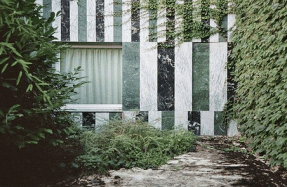The Ordinary is a Perennial Architectural Inquiry: Rethinking the Everyday of the Keunseng Through Learning from Las Vegas
Seunghan Paek
keywords: the ordinary/everyday, keunseng, Sinchon,
Las Vegas, Stanley Cavell, Aron Vinegar, skepticism, community, multiplicity, façade, signage
Abstract
Seunghan Paek is an assistant professor in the School of Architecture at Catholic Kwandong University in Korea, where he teaches design studios and lectures on architectural history, theory and criticism. His research interests are in urbanism as broadly defined, with particular focus on issues of the everyday, affect, atmosphere, assemblage, new materialisms, the Anthropocene, and critical heritage studies.



On Ways of Seeing in the Everyday
In this article, I claim that the issue of what constitutes the everyday cannot be resolved in simple terms, because each individual encounters their surrounding environment in a different way entangled with shifting perceptions and emotional responses that exist beyond external influences. The rationale behind such a claim lies with a critical reconsideration of how the ‘ordinary/everyday’ has been theorized, especially in architecture, in which it is often used in reference to certain strands of scholarship that emphasize the spectacular and alienating elements of life in the post-war capitalist society. In this respect, the way that philosopher Henri Lefebvre defined the term is worth noting: ‘Today we see a worldwide tendency to uniformity. Rationality dominates, accompanied but not diversified by irrationality’. ▼1 What Lefebvre refers to, in an essay originally published in 1972, is a world that is heavily influenced by the logic of capitalism in the European context, and the array of institutional and commercial forces through which one’s sense of autonomy is only partially guaranteed. The vast range of items one comes across in grocery stores and shopping malls, and the myriad advertisements that fill our streets and television screens are some of the defining features of this society that Lefebvre found particularly objectionable. In other words, he considered everyday life to be unidirectionally probed by external forces, which override individual capacity and more flexible forms of living in a top-down and disciplinary manner.
However, others, such as Jean-Luc Nancy (1940 – ), challenge these ideas with the claim that one is unable to externalize oneself from the everyday as if it were an apparatus or system to be attached or detached at will. What Nancy advances instead is the essential difficulty of grasping the essence of the everyday, noting that ‘[t]he everyday […] remains in its nonappearance’ in his book Philosophical Chronicles. ▼2 In the same paragraph Nancy continues: ‘As soon as we make it [the everyday] appear – in a thought, a painting (just as one used to speak of a ‘theater of everyday life’) – we lose it, we make it come forth as an event, or we make an event spring up in contrast to it, eclipsing it’. ▼3 The point here is that the everyday is not comprehensible in a complete sense due to its fragile and ephemeral nature, and as soon as one tries to grasp the essence of the everyday by making it an event, a painting, and a work of architecture, it is doomed to evaporate and remains ungraspable. But this does not mean that trying to grasp its essence is futile. What I suggest in its place is the need to pay close attention to the subtle, fleeting and unstable instances found in the everyday, which resonate with unfolding pulses and unanticipated rhythms, and to avoid appropriating these instances for the sake of achieving something new. ▼4
Keeping in mind that there are different ways of seeing the everyday, as well as a growing scholarship that observes the phenomenon and its multiplicity, I here explore the openness of the everyday in the context of Korean cities and especially in commercial settings. Structurally speaking, the article consists of two parts. The first is to analyze Aron Vinegar’s book, I am a Monument: On Learning from Las Vegas (2008). The book revisits one of the classic texts of postmodern architecture: Learning from Las Vegas (first published in 1972 with a revision in 1977) coauthored by Robert Venturi (1925 – 2018), his lifelong partner Denise Scott Brown (1931 – ), and Steven Izenour (1940 – 2001). Vinegar’s book is not a simple review of this canonical text but uses it as a threshold from which to explore the philosophical dimensions of the everyday and puts their work in conversation with two philosophers—Jean-Luc Nancy and Stanley Cavell (1926 – 2018). ▼5 Second, I will contribute a case study that analyzes a roadside building located in the Sinchon commercial district of Seoul, which is here named ‘Seodaemungu Changcheon-dong 33-9 Building’ according to its administrative address. What I hope to related through this case is the complexity to be found in the everyday, one that cannot be reduced to our general rubrics of spectacle, private consumption, or the culture industry.

Rethinking the Everyday in South Korean Urban Culture
Locating the contrasting, and often in fact conflicting, conclusions drawn by Lefebvre and Nancy of the everyday is interesting but not surprising,
You’re reading a preview, subscribe to read more.
Start your free 30 days





